Site pages
Current course
Participants
General
20 February - 26 February
27 February - 5 March
6 March - 12 March
13 March - 19 March
20 March - 26 March
27 March - 2 April
3 April - 9 April
10 April - 16 April
17 April - 23 April
24 April - 30 April
Lesson 14. WOOD WORKING TOOLS AND THEIR WORKS
Module 7. Carpentry
WOOD WORKING TOOLS AND THEIR USE
14.1 Marking and Measuring Tools
14.1.1 Carpenters’ folding rule
This is a wooden scale used for measuring and setting out dimensions. It consists of four pieces each 15 cm long hinged at the ends to make folding. When opened out its total length is 60 cm.
14.1.2 Straight edge
The straight edge is a machined flat piece of wood or metal used for testing the trueness of surfaces.
14.2 Try square
Try squares are used for a variety of purposes like measuring and setting out dimensions, testing flatness, drawing parallel lines at right angles to a plane surface and checking square ness of two adjacent surfaces. A try square consists of a steel blade with a wooden or cast iron stock. Sizes vary from 150 to 300 mm according to the length of the blade. The blade is graduated to serve as a scale.
14.3 Gauges
Gauges are very important carpentry tools used for marking and for cutting. A gauge essentially consists of a small square or rectangular wooden stem sliding in a wooden stock. The stem carries one or more steel marking points or a cutting knife. The gauge is then held firmly against a planed surface and pushed along to get the required markings.
The three commonly used gauges are marking gauge, mortise gauge and cutting gauge.
The marking gauge has one marking point. It gives an accurate cut line parallel to a true edge, usually along the grain. The mortise gauge has two marking points one fixed near the end of the stem and the other attached to a sliding bar. The two teeth cut two parallel lines, called mortise lines needed for joints etc.
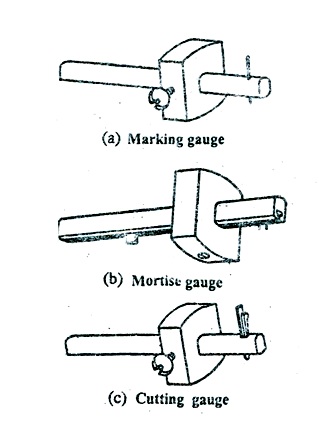
Fig. 14.1 Gauges
14.4 Cutting Tools
Saws:
All the saws used in wood working essentially consist of two main parts-the blade and the handle. The blade carries the cutting teeth and is made of steel. The handle is made of wood and is used for holding the blade and applying pressure. The teeth of the saw are given a set to prevent the saw from binding during the sawing operation.
The saws are classified as push cut saws or pull cut saws depending upon whether they cut in the forward stroke or in the return stroke. Push cut saws are in more common use than pull cut saws.
Saws are generally specified by the length of the blade measured along the toothed edge and pitch of teeth expressed in millimeters.
The common types of saws used in wood working are the following:
1. Rip Saw: Rip saws are used for cutting along the grains in thick wood. The blade is about 120 to 200 mm wide near the handle and about 60 to 100 mm near the tip. The cutting action starts from near the tip and gradually the whole length is involved. The length of the blade is about 700 mm and the tooth pitch 5 to 8 mm.
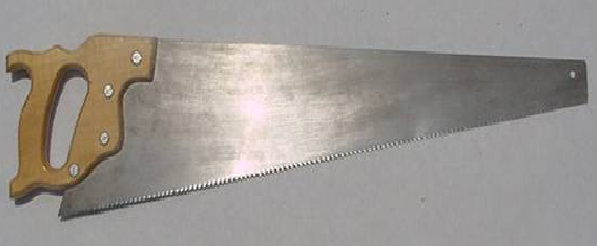
Fig 14.2 Cross cut saw
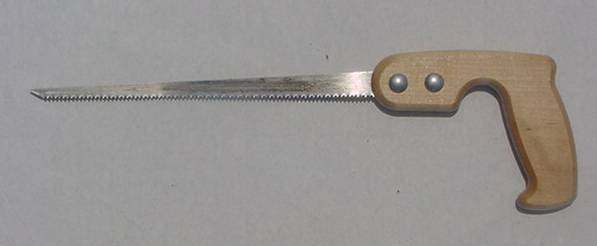
Fig. 14.3 Compass saw
14.5 Chisels
A large variety of chisels is used in carpentry work for removing wood varying from very fine shavings removed by hand pressure to thick sections removed with the help of a mallet.
Chisels have forged steel blades fitted into wooden handles and are specified by the shape and width of the blade.
The four common types of chisels are following
1. Firmer Chisel: This chisel has a flat blade about 100 to 150 mm long and 3 to 5 mm thick. It is the most general purpose chisel. It is used by hand pressure or mallet depending on the amount of material to be removed. Width varies from 3 to 50 mm.
2. Bevelled Edge Firmer Chisel: Also known as dovetail chisel this type of chisel has beveled edges as shown. The beveling of the edges reduces the thickness of the chisel at the sides enabling it to enter sharp corners and finish them. This chisel is used for fine and delicate work
3. Paring Chisel: Firmer and beveled edge firmer chisels when made with long thin blade are known as paring chisels. Such chisels are generally manipulated by hand and are 5 to 50 mm wide and 225 to500 mm long.
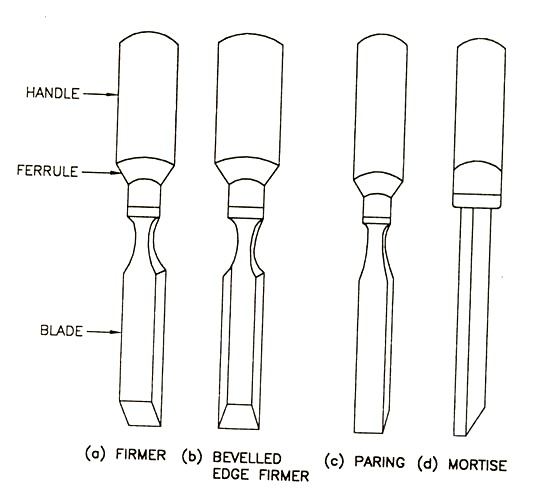
Fig. 14.4 Types of chisels
Axe:
The axe consists of a steel head and a wooden handle. It is used for removing the back etc. from the wood and for splitting the logs.
14.6 Planning Tools
In the past all planes were made out of high quality wood but metal planes have now replaced wooden planes. As compared to wooden planes metal planes are more efficient, can be used with greater control, can be easily adjusted and give better finish. The planes more commonly used include the following:
14.7 Wooden Jack Plane
A jack plane is the first plane used on timber for trueing it. It consists of a block of wood or stock into which the blade is fixed with a wooden wedge. The bottom face of the stock called sole is made perfectly smooth and level. The blade made of high carbon steel is fixed at 45 degrees to the sole and is held in position by atapered wooden wedge. Another blade is fixed on the cutting block between the blade and the wedge. This does not do any cutting but only supports the cutting blade and prevents shattering. It also helps in breaking the shavings as they are produced by making them curl. Jack planes are 350 to 425 mm long with blades 50 to 75 mm wide.

Fig. 14.5 Wooden jack planes
14.8. Metal Jack Plane
Metal jack planes serve the same purpose as wooden jack planes but facilitate a smoother operation and better finish. The body of a metal plane is made from a gray iron casting with the sides and sole machines and ground to a bright finish. The thickness of the shaving removed is governed by a fine screw adjustment and a lateral adjustment lever is used for adjusting the blade at right angles.
Other planes:
2. Smoothing plane : Small in size and used for smoothing and finishing.
3. Rebate plane : For making recess along the edge of the wood piece.
4. Plough plane : For making small grooves where panel fitting is required.
14.9 Boring Tools
Boring tools are needed frequently for making round holes in wood. They are selected according to the type and purpose of the hole.
Spring bit:Spring bit is used for drilling holes not larger than 5 mm in diameter. It maybe driven in by a hammer or with an oscillatory motion of the hand. It is chiefly used for making lead-holes for large nails or screws.
Brace : Used for holding and turning bit for boring holes. It may be a ratchet or wheel brace type.
Auger:Auger is a long steel bar with a fluted body for half of its length and an eye at the top through which a handle can be fitted for turning the auger. A small screw is provided at the bottom of the auger to serve as a pilot in starting a hole. The anger is operated by holding the handle in both hands and rotating while simultaneously pressing downwards. Augers are chiefly used for rough structural work and are available in various sizes up to 25 mm diameter. Small auger bits are also available for use with braces.
Gimlet: A gimlet is a smaller form of auger and is used for producing small holes. It is operated in the same way as the auger.
Auger Bit: An auger bit as mentioned earlier is a small auger. It has a screw point and a helical or twisted stem. This bit produces long, clean and accurate holes from 6 to 35 mm diameter a longor across the grains. Since the whole body of the bit is fluted, removal of shavings is easier and as such this bit is extremely useful for drilling deep holes.
Counter sink Bit: This bit is used for making conical depressions to receive screws etc. This bit is also known as arose bit.
14.10 Striking Tools
Striking or impelling tools are used for driving chisels and nails into the wood and for assembly work. The two types of striking tools used for wood-working are (i) mallet and (ii) hammer.
Mallet: A mallet is a small wooden hammer of round or rectangular cross section. It is made of hard wood. A mallet is used to give light blows to the cutting tools with wooden heads such as chisels and gouges.
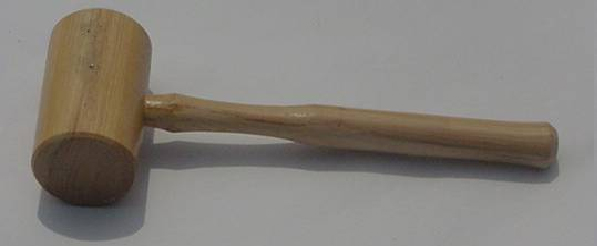
Fig. 14.6 Mallet
Hammers: Twotypes of hammers are normally used in wood working: cross peen hammer and theclaw hammer. The cross peen hammer is used for light bench work. It has caststeel head with the face and peen being tempered. The handle is made of eitherwood or bamboo. These hammers are specified by size number and range from 200gm. to 550 gm.
The claw hammer in addition tobeing used as a hammer, can also be usedfor pulling out bent nails and for this reason it is preferred by the woodworkers. These hammers are available in four sizes weighing 375, 450, 550 and675 gm.
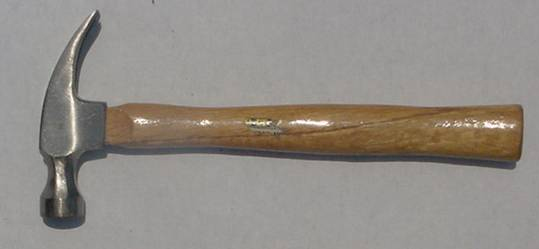
Fig. 14.7 Claw Hammer
Holding andSupporting Tools:
Thiscategory of tools is used for holding and/or supporting the job duringoperation. For accurate work the job must be properly held and supportedagainst the forces being applied to cut or shape it. The commonly used tools inthis category include the following:
14.11 WorkBench
The work bench is a heavy rigid table made of hard wood. It isusually 3 to 3.65 metres long. 0.7 m wide and 0.7 m high. A double bench is3.75 to 4.3 m long 0.9 m wide and 0.7 m high. Two or four carpenter’s vises arefitted on opposite sides of the bench to hold jobs. Racks may be provided inthe table for storing tools, finished jobs and other equipment.
14.12 BenchVice
The bench vise most commonly used for wood working has one jaw fixedto the side of the table while the other can be moved by means of a screw. Thescrew works inside a fixed half nut and is operated with a handle. The inside surfaces of the jaws are fitted with wooden liners to prevent scratching of thework piece surfaces when they are clamped.
Bench Stop: The bench stop is simplya block of wood projecting above the top surface of the bench. This is used toprevent the wood from sliding forward during planning.
Bar Cramp: The bar or sash cramp is made up of a steel bar of rectangular or T-section which carries a screw inside. The screw is provided with a handle at one end while the other end is attached to a jaw as shown in Fig. 14.8. Another jaw is mounted on the bodyand can be fixed anywhere on the bar with the help of a retaining pin. The bar cramp is used for holding wide work pieces such as door frames.
Cramps and Screws: Cramps and screws of various types and sizes are commonly used by woodworkers for holding odd shape work pieces. Two of the most common ones are the C-Clamp and hand screw.

Fig. 14.8 C-Clamp with hand screw
Miscellaneous tools:
Rasps and files : there are used for cleaning by some curvedsurface.
Pincelr: It is making used for pulling out nails, tacks etc.
Screw drivers : They are used for screwing or unscrewing screw used inwood. Screw drivers used for carpentry work are available with long handles andstrong nose